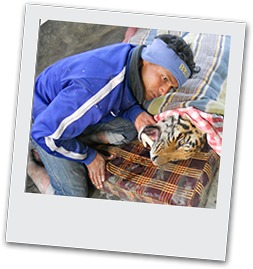OUR STORY OF REZVIN CONTINUED: Understanding the role of communication to stop the killing of stray tigers
….The people survived rough storms and devastating cyclones because the Sundarbans took the main blows first. They are fed by the Sundarbans, they fish in the beautiful creeks and rivers and  they collect honey. They only hate the tiger because of fear. Wouldn’t you feel anxiety, if you were in their shoes?
they collect honey. They only hate the tiger because of fear. Wouldn’t you feel anxiety, if you were in their shoes?
In stories told by grandparents and wise men, the tiger is a sacred animal. The powerful, enormous cats are even seen as the child of the Sundarbans. Both forest and tiger have a strong religious meaning, deeply rooted in the culture of the villages.
Knowing now what would motivate the villagers, we went back. We told them that the Sundarbans are mother-like: it protects and nurtures us like our mother. Next step was to tell villagers that we have a solution for the stray tigers. It’s possible to save both men and tigers. Why is this important for the villagers? Because the sacred tiger protects the Sundarbans. The child protects his mother. Without tigers, illegal loggers will move in and  destroy the forest. Development will rapidly increase. And the villagers will lose the shelter and care of the Sundarbans.
destroy the forest. Development will rapidly increase. And the villagers will lose the shelter and care of the Sundarbans.
We invited villagers to join our tiger team training program. They learn how to scare tigers back into the forest. Sometimes a tiger is so far inside the village, the mighty beast can’t be scared back. We train the team members in crowd control, so they know how to stop and calm panicking villagers. While they manage the roaring crowd, the alarmed Forest Department puts the tiger to sleep. Before, a tiger killer was a hero. Now, members of the Tiger Response Teams are heroes and tiger killers are looked down upon. Because the tigers protect them from outside forces. If the tiger stays, they will stay as well.

Many tigers are saved since then. And the word spreads fast. We now get requests from new villages to start our tiger training programs. There is a waiting list for volunteers in the fifty villages with Tiger Response Teams. On their own initiative, some of the teams help to stop poaching and protect wildlife. They even set up junior teams to mobilize the younger generation. They tell a story that sticks: ‘The Sundarbans protect us, the tiger protects the Sundarbans, by saving the tiger, we protect ourselves’.
